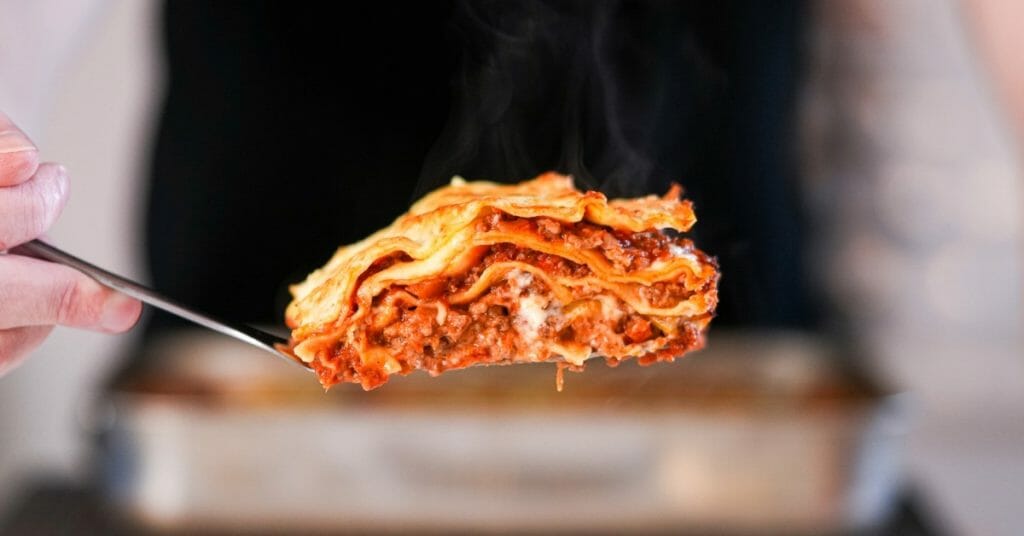Traditional Lasagna
This traditional lasagna recipe is easy to make and uses cheap everyday ingredients to create a delicious dish. I’m not going to lie to you and say this is quick because it isn’t, but it’s worth every minute when you taste the final product. This lasagna recipe does contain alcohol, and substitutes are included, making this recipe accessible to everyone.

Lasagna
Ingredients
Meat Ragu
- 2 Tbsp (40ml) - Olive Oil
- 1 ½ - Brown (Yellow) Onions, Diced
- 1 - Celery Rib, Diced
- 2 - Carrots, Diced
- 500g (1.1lb) - Beef or Veal Mince
- 500g (1.1lb) - Pork Mince
- 1 Cup (250ml) - Red Wine
- 1.2kg (2.1lb) - Canned Diced Tomato or Passata
- 1 Cup (250ml) - Beef Stock or Water
- Pecorino Romano or Parmigiana Reggiano
- Mozzarella To Taste
- Fresh Lasagne Sheets
- Seasoning To Taste
Bechamel Sauce
- 800ml (800g) - Full Fat Milk
- 90g (3.1oz) - Unsalted Butter, Cubed
- 90g (3.1oz) - Plain All-Purpose Flour, Sifted
- ½ - Brown Onion
- 2 - Bay Leaves, Dried
- 3 - Whole Cloves
- ¼ tsp (0.2g) - Ground Nutmeg
- 50g (1.5oz) - Parmigiana Reggiano, Freshly Grated
Instructions
Meat Ragu
- Heat the olive oil in a large pot over medium-high heat. Once hot, add the onion, carrot, celery and a pinch of salt and sauté for 5-6 minutes, stirring frequently. Add the beef or veal mince and pork mince and cook, breaking it up for 5-6 minutes. Season to taste
- Pour in the red wine and allow to cook for 5 minutes or until reduced by ⅔ and check and adjust seasoning levels. Add the crushed tomatoes or passata and mix well. Bring the sauce to a simmer and place on a lid. Reduce the heat to low and cook for 1 hour, stirring occasionally.
- After 1 hour, remove the lid and stir well. Check and adjust seasoning levels and add in the beef stock or water. Mix well and cook with the lid off for 1 hour, stirring occasionally. Remove from the heat.
Bechamel Sauce
- To create an onion cloute (pique), with ½ brown (yellow) onion, place the bay leaves onto the onion & use the cloves as nails to pin the bay leaves on. This is optional and acts as an infuser.
- Pour the milk into a saucepan, add the onion cloute (pique) if using, and place over medium heat, allowing the milk to come to a Luke warm heat. Remove from the heat and remove the cloute (pique). This can be saved and used in a stock.
- Melt the unsalted butter in a separate saucepan over medium heat, then add the flour. Mix well to create a roux and cook for 1-2 minutes, mixing frequently to avoid burning.
- Mix two ladles of warm milk into the roux until fully incorporated before adding more. Repeat until all the milk has been added. Once smooth, remove from the heat. Grate in nutmeg, season with salt and pepper and grate the Parmigiano Reggiano cheese. Mix well until smooth. Set aside.
Assembling Lasagna
- Preheat oven to 180°c - 350°f. Grease a large baking dish with butter or oil (recommended size 30cm x 20cm).
- Spoon 1 to 2 ladles worth of sauce into the bottom of the tray & spread it out evenly. Place over the lasagne sheets to cover the sauce. Don't allow them to overlap much. Pour over one ladle worth of bechamel sauce, spread it around evenly & cover the lasagne sheets entirely. Repeat the process with meat sauce, lasagna sheets & bechamel, finishing with bechamel on the top. Grated cheese and mozzarella can also be added in between layers.
- Cover the lasagna with aluminium foil, bake in the oven for 25 to 30 minutes, and remove. Carefully peel off the foil and grate over enough pecorino Romano or parmigiana Reggiano Cheese to cover. Place back into the oven for 10 minutes or until golden. Remove and let cool before serving.
- Serve on plates or in bowls with salad and garlic bread or on its own. Garnish with basil. Dig in.
Nutrition Guide
The above nutrition guide is based on daily averages and is calculated for a single portion.
Recipe Notes
Traditional Lasagna Storage Instructions
Place the lasagna into airtight containers and place it in the fridge for up to 3 days. As for freezing, place into airtight containers and store in the freezer for up to 4 months. Thaw in the refrigerator overnight before reheating.
Traditional Lasagna Reheating Instructions
Place the lasagna into an oven set at 180.c (350.f) for 10-15 minutes. If you’re reheating it this way, creating a marinara or tomato sauce to pour over the top and give it some rehydration is beneficial (optional). Alternatively, place the lasagna into the microwave in bursts until hot in the centre.
Additional Notes
- If you’re using store-bought dried lasagna sheets, follow the instructions to prepare them before assembling the lasagna. Some sheets don’t require prior blanching, so check the instructions carefully; otherwise, you could end up with uncooked lasagna.
- If you can’t consume alcohol. Beef, vegetable or chicken stock can be used.
- You’re welcome to finish the top layer with the ragu. Each to their own.
Watch How To Make The Recipe
Did You Like This Recipe?
Please take a second to leave a comment and rating below, and I’ll get back to you as soon as possible.
